Throwback Thursday: The Green Flash
The physics of one of the rarest and most spectacular sunset sights ever seen!
Image credit: © Mila Zinkova / Creative Commons.
“It does no harm to the romance of the sunset to know a little bit about it.”
–Carl Sagan
Forget about harm; there’s truly nothing I know of that enhances the romance, joy and beauty you find in the natural world quite like a bit of knowledge does. In addition to the spectacular perception that our senses can experience, there’s nothing in the world like having your mind engaged, uncovering layer after deeper layer of what you’re taking in.
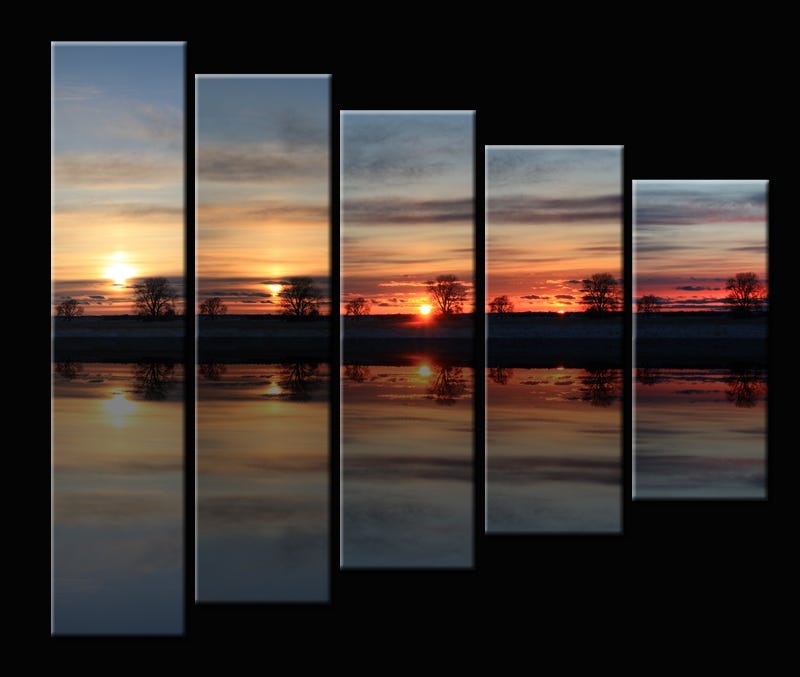
In those moments, the abstract and the concrete merge together, creating the most human of all experiences: one where both the primitive and the higher-functioning parts of our brain are all focused simultaneously on the phenomenon at hand.
The next time you watch the Sun descend through the sky on a clear evening, towards the western horizon, you might marvel at how the Sun remains the same apparent size all the way down. At just slightly over half-a-degree, the Sun appears to drop at a constant rate throughout the afternoon and into early evening. But there are some small, noticeable changes that are extremely important if you want to understand the beauty behind the sunset, and its most elusive of secrets.
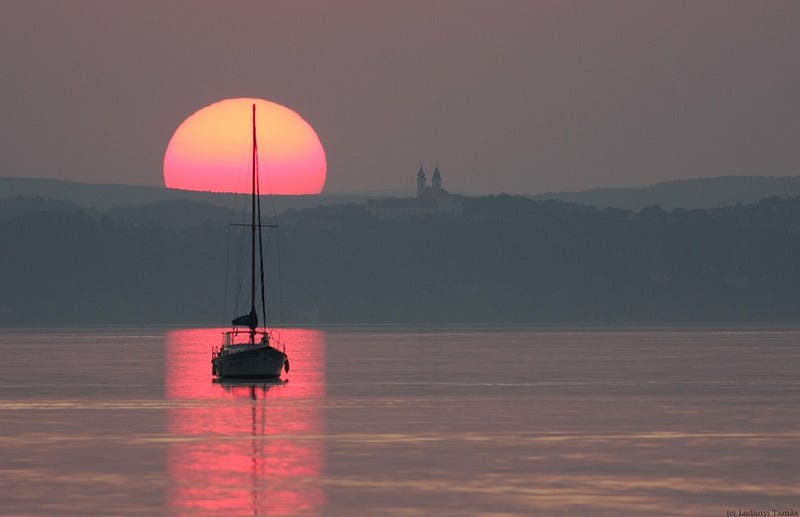
Let’s start at the most striking of changes and work our way toward the more subtle.
The first and most obvious is the change in coloration of the Sun, which comes alongside a severe drop in the Sun’s brightness. You might notice that during midday, a glimpse of the Sun is blinding, but when it’s very low on the horizon, it’s far less painful to look at it. (Although you still probably shouldn’t.) However, on an airless world like the Moon or Mercury, the Sun at sunset would look no different than at any other time. It’s the Earth’s atmosphere that makes sunsets so special for us.

When the Sun appears progressively lower and lower on the horizon, its light needs to pass through more and more of the atmosphere to reach our eyes. When the Sun is directly overhead, there’s only one atmosphere’s worth of material to pass through before sunlight hits our eyes, taking up around 60 miles (100 km) of space, total.
You might not think of the atmosphere as being a very good prism, but when you pass through around 1000 miles (1600 km) of it just before the Sun dips below the horizon, it starts to add up.
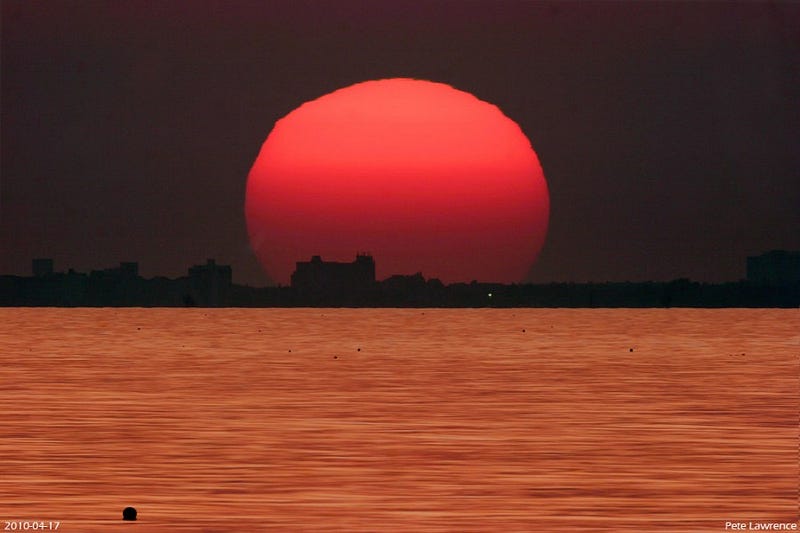
The bluer wavelengths of light get scattered away very strongly. This same phenomenon turns the sky blue when the Sun is directly overhead, as the scattered blue light careens off the atmosphere, arriving at our eyes. But when the Sun is low on the horizon, passing through some 15+ times as much atmosphere, that blue light scatters away, leaving only the reddest wavelengths — which scatter much less — to reach your eye. As the Sun drops towards the horizon, it progressively loses violets and blues, then greens and yellows, and finally even the oranges, leaving primarily the reds behind.
You may not even realize it, but by time you’d see a sunset like the picture above, the Sun has already technically set, it’s only due to the fact that the atmosphere also bends (or refracts) light that we’re still seeing it like this.

Have you ever tried to time a sunset over the ocean? To measure the amount of time it takes from when the bottom of the Sun’s disk hits the water until the top of the disk disappears below it? Since the Sun makes a 360-degree path through the sky, takes up half-a-degree in diameter, and there are 86,400 seconds in a day, you’d expect it to take 120 seconds to go from the moment it touches the horizon to the moment it dips below. Because the Sun’s path is curved during most days from most latitudes on Earth, the optimal time to measure this is during the equinox from equatorial latitudes, where it rises and sets as close to completely vertical to the horizon as possible. Yet even if you time it under those conditions, the Sun appears to linger for quite a bit longer due to the refraction of our atmosphere.
Also, despite its red appearance, there really still is blue and green light coming from the Sun, of course, while this is going on. There simply isn’t as much of it. But these shorter (i.e., bluer) wavelengths refract slightly more than the lower frequency ones, meaning that the reds come in at a different, shallower angle than the greens and blues, that come in at a slightly steeper angle.
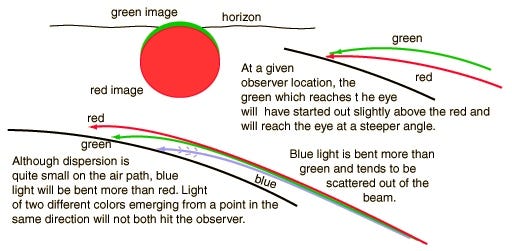
Given a clear path to the horizon — such as over the ocean — this means that there’s a slight region of space just above the reddened Sun where only the shorter wavelength light is visible!
And when that happens, in addition to the normal color gradient that comes with a sunset, you can also get a small, separate region above the disk of the Sun that appears yellow, green, or even blue! (And much fainter than the rest of the Sun!)
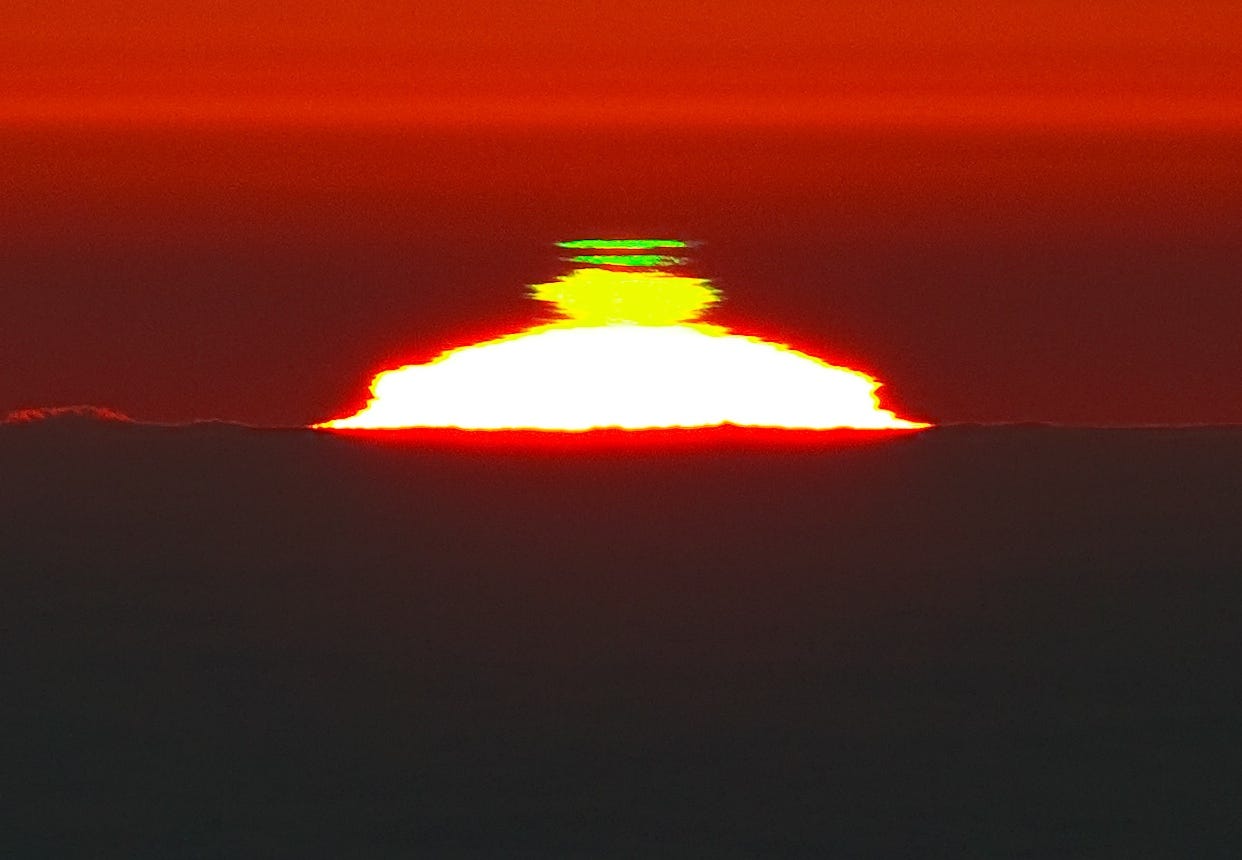
This optical phenomena is always most clearly visible over a flat area in pollution-free skies, and is known as the green flash. It occurs in many different stages, sometimes appearing at the limb of the Sun or just above it, but most it commonly appears just after the disk of the Sun has set, in a literal “flash” lasting just a few seconds, just barely above the horizon.
Because it’s so much dimmer than the Sun, the best time to view it is immediately after that final portion of the Sun’s disk (as defined by the red light) drops below the horizon, but where a tiny bit of the bluer wavelengths remain.

Although there’s a lot of green light in the Sun, the bluest wavelengths refract even more than the green ones do. In principle, you could get a “flash” of any wavelength — yellow, green, blue, or even violet — if the atmosphere cooperated. Although green and yellow flashes are the most common, under just the right atmospheric conditions, you can see even blue colors flashing at a high angle above the top of the Sun!
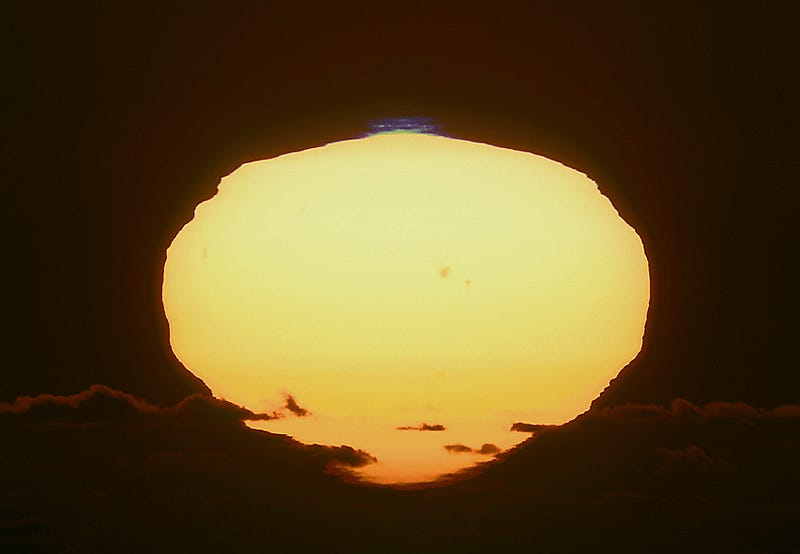
This applies to any very bright, white-light object that encounters our atmosphere as seen just barely above the horizon.
So that means the Moon, which reflects sunlight back at us, should also exhibit a green flash under the right atmospheric conditions. And although I’ve never seen it with my own eyes, some diligent astrophotographers have captured the sight to share with us all.
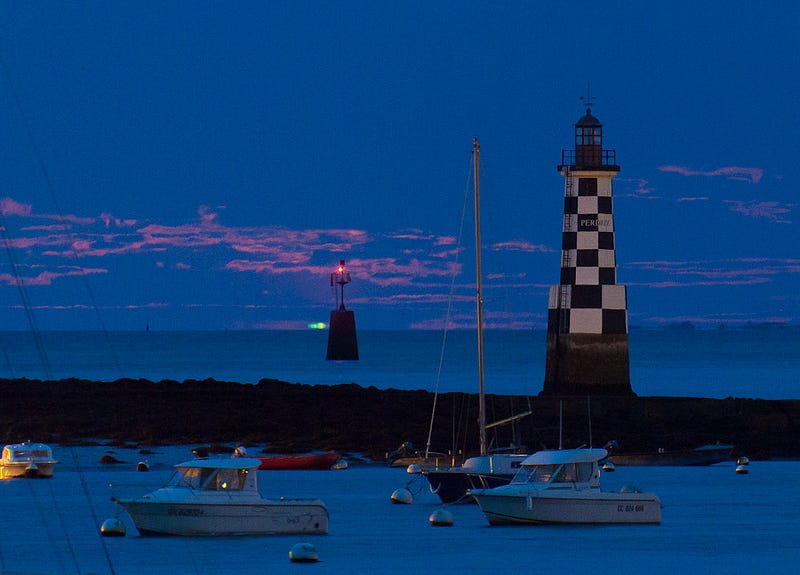
Think about why this is happening again: the red wavelengths are being refracted a little more than the yellows, greens and blues, meaning that the red-light disk is just slightly lower on the horizon than the disk from the other wavelengths.
You may be wondering, then, if greens and blues appear slightly above the disk of the Sun (or Moon), could we ever see a red flash slightly below the disk? Under just the right, favorable atmospheric conditions, that’s exactly what happens!
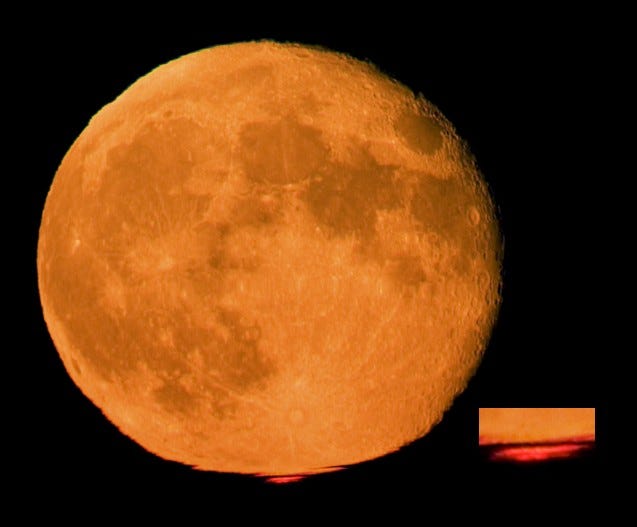
Just as there can be a green or even a blue flash above the Sun or the Moon when it’s very low on the horizon, there can be a red flash below the Sun or Moon at the same time! It’s just often harder to see, because there’s a little less atmosphere to go through from that one degree of difference.
Put all of this physics together — the light, the Earth’s atmosphere, scattering and refraction — and put it together under the right conditions, and that’s what gives you the physics of the green flash!
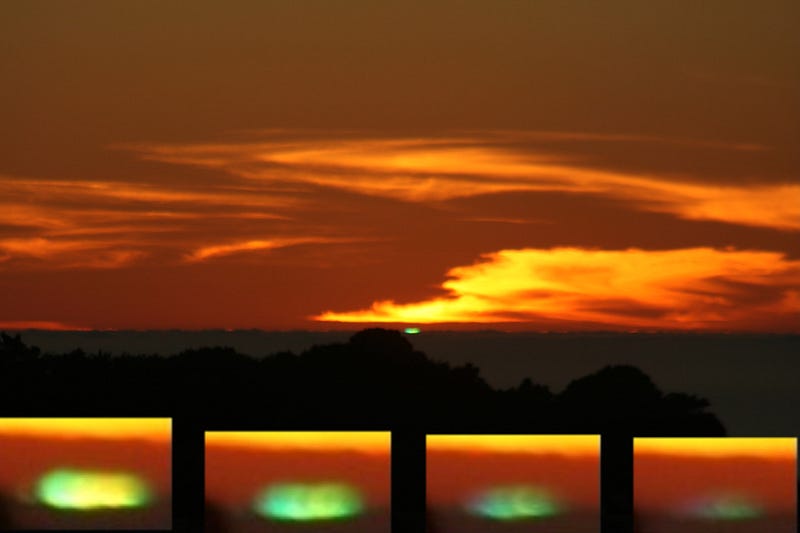
But here’s a little bonus for those of you who made it this far. Way back on the original blog (nearly six years ago), I posted a short explanation of the green flash, and little did I know that years later, I would receive the following message from Don Arnold of Chattanooga, TN:
I thought this was a hoax every time I visit Costa Mesa..so last week we were on the costa mesa pier and had my good Nikon set the motor drive to max and took 30 frames right at sunset. So I think I have a good one. You will have to zoom in but it looks good…thanks for the great explanation on this!
Here was the image he enclosed.

What does this look like up close? Here is the zoomed-in-version (and my apologies for my lousy image processing skills):
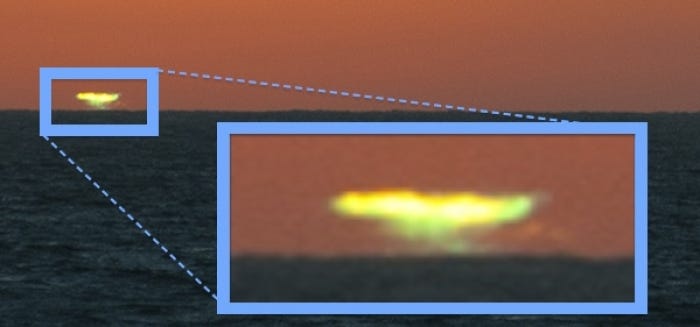
The sunset is beautiful to anyone’s eyes, and the clarity or dustiness of the horizon, the quality and turbulence of the atmosphere, and position of the Sun give us a great diversity of beautiful sights.
But when you see a color gradient on the Sun, a red lip at the bottom, or a yellow, green, or blue rim at or above the top, will you see less beauty or more for having read and understood this? To me, at least, everything is more beautiful the more you know. Thanks for sharing the beautiful physics of sunsets with me, and keep an eye out for the inimitable green flash!
Enjoyed this? Comment at the Starts With A Bang forum on Scienceblogs!





